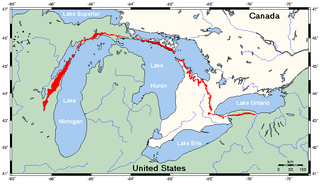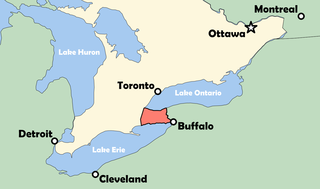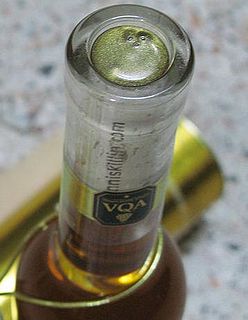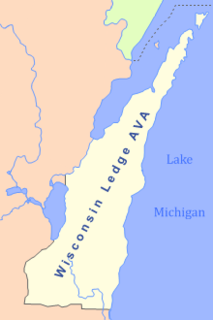The Short Hills Bench is a sub-appellation of the Niagara Peninsula (St. Catharines, Ontario, Canada).
The Short Hills Bench is a sub-appellation of the Niagara Peninsula (St. Catharines, Ontario, Canada).
A Carolinian Climatic Zone, the Short Hills Bench has been acknowledged for its unique soils, topography and climate by the governing body of wine production, the Vintners Quality Alliance Ontario (VQA) and by the United Nations as part of a UNESCO World Biosphere Reserve within the Niagara Escarpment. The region supports flora from black walnut trees, paw-paws, willows, tulip trees and conifers to fauna including possums, coyotes, wild turkeys, and white-tailed deer.
The Short Hills Bench forms a shelf of land jutting out of the Niagara Escarpment midway up and bounded to the east by a valley of “short hills” carved by small creeks. This valley, now the Short Hills Provincial Park, was the original pre-glacial course of the Niagara River and site of an ancient rendition of Niagara Falls. The Short Hills Provincial Park is the headwaters of the 12 Mile Creek which flows north to Lake Ontario. To the south and west the Short Hills Bench is bounded by the dolomite capped rock-face of the Niagara Escarpment while its northern boundary is an open plain that ends at the top of a series of steps leading to Lake Ontario.
The Short Hills Bench is a shale and limestone basin, 30 – 40 feet (12 m) of glacial clay and silt and a 1 – 2-foot (0.61 m) mixture of clay-mixed top soil. Air and water flows to the east and the north but the area's wine-grape growers are required to under-drain their vineyards to remove excess moisture from the slow drying clay. This same clay limits the vines’ ability to produce large crops. It is typical for vines to produce small yields of tiny berries with high concentrations of sugars, acids, minerals and other flavour compounds. Still, the non-uniform glacially deposited soils do contain different minerals at different depths and locations. This results in wines with flavours unique to each parcel of land, particularly as the vines grow older, sending their roots deeper into soils.
A high proportion of the Niagara Peninsula's south and south-east facing slopes are located in the Short Hills Bench. Fruit grown on these slopes have intense sun-exposure and hence high ripeness relative to fruit grown elsewhere in the Niagara region. The ground warms quickly in the morning, due in part to the relatively high altitude (above the cooler lake winds of summer) and in part to the distance south of Lake Ontario. This is a benefit to the vines as it stimulates them to photosynthesize, essentially “waking them” early in the day and “putting them to bed” later in the evening. The region gets some of the longest daily and seasonal growing time in the overall short but intense season.
During the winter it is the relatively high elevation of the Short Hills Bench which allows it to benefit from rising warm air currents blowing south off Lake Ontario, in much the same way as the lower lying coastal sub-appellations do. This warm air has a moderating effect on the mesoclimate, protecting the tender buds from potentially damaging frosts.
Fruit from this region is sourced by many wineries in Niagara and Ontario. As of 2007 two wineries call this sub-appellation home, Henry of Pelham Winery and Hernder Estate Winery. A large Burgundian house recently planted a 40-acre (160,000 m2) site adjacent to the Short Hills provincial park.

The Niagara Escarpment is a long escarpment, or cuesta, in Canada and the United States that runs predominantly east–west from New York through Ontario, Michigan, Wisconsin, and Illinois. The escarpment is most famous as the cliff over which the Niagara River plunges at Niagara Falls, for which it is named.

Riesling is a white grape variety that originated in the Rhine region. Riesling is an aromatic grape variety displaying flowery, almost perfumed, aromas as well as high acidity. It is used to make dry, semi-sweet, sweet, and sparkling white wines. Riesling wines are usually varietally pure and are seldom oaked. As of 2004, Riesling was estimated to be the world's 20th most grown variety at 48,700 hectares, but in terms of importance for quality wines, it is usually included in the "top three" white wine varieties together with Chardonnay and Sauvignon blanc. Riesling is a variety that is highly "terroir-expressive", meaning that the character of Riesling wines is greatly influenced by the wine's place of origin.

The Niagara Peninsula is an area of land lying between the southwestern shore of Lake Ontario and the northeastern shore of Lake Erie, in Ontario, Canada. Technically an isthmus rather than a peninsula, it stretches from the Niagara River in the east to Hamilton, Ontario, in the west. The peninsula is located in the Golden Horseshoe region of Southern Ontario, and has a population of roughly 1,000,000 residents. The region directly across the Niagara River and Lake Erie in New York State is known as the Niagara Frontier.

Grüner VeltlinerGerman: [ˈgʁyːnɐ fɛltˈliːnɐ](listen)) is a white wine grape variety grown primarily in Austria, Hungary, Slovakia, and the Czech Republic. The leaves of the grape vine are five-lobed with bunches that are long but compact, and deep green grapes that ripen in mid-late October in the Northern Hemisphere.

McLaren Vale is a wine region in the Australian state of South Australia located in the Adelaide metropolitan area and centred on the town of McLaren Vale about 38 kilometres (24 mi) south of the Adelaide city centre. It is internationally renowned for the wines it produces and included within the Great Wine Capitals of the World. The region was named after either David McLaren, the Colonial Manager of the South Australia Company or John McLaren (unrelated) who surveyed the area in 1839. Among the first settlers to the region in late 1839, were two English farmers from Devon, William Colton and Charles Thomas Hewett. William Colton established the Daringa Farm and Charles Thomas Hewett established Oxenberry Farm. Both men would be prominent in the early days of McLaren Vale. Although initially the region's main economic activity was the growing of cereal crops, John Reynell and Thomas Hardy planted grape vines in 1838 and the present-day Seaview and Hardy wineries were in operation as early as 1850. Grapes were first planted in the region in 1838 and some vines more than 100 years old are still producing. Today there are more than 88 cellar doors in McLaren Vale. The majority are small family-run operations and boutique wineries.

Vintners Quality Alliance, or VQA, is a regulatory and appellation system which guarantees the high quality and authenticity of origin for Canadian wines made under that system in British Columbia and Ontario. It is similar to regulatory systems in France (AOC), Spain (DO), Italy (DOC), and Germany (QmP). The VQA system allows for sub-appellations, by which the grapes for wines are sourced from extremely specific geographical locations with different soil and climate. This is in accordance with the concept of terroir.

Vidal blanc is a white hybrid grape variety produced from the Vitis vinifera variety Ugni blanc and another hybrid variety, Rayon d'Or. It is a very winter-hardy variety that manages to produce high sugar levels in cold climates with moderate to high acidity.

Short Hills Provincial Park is a provincial park located in the centre of the Niagara Peninsula, bordering the city of St. Catharines and the town of Pelham in the Niagara Region in southern Ontario, Canada. It occupies an area of 660 hectares. It also borders the new vineyard sub-appellation called the Short Hills Bench.

Canadian wine is wine produced in Canada. Ontario and British Columbia are the two largest wine-producing provinces in Canada, with two-thirds of the Canada's vineyard acreage situated in Ontario. However, wine producing regions are also present in other provinces, including Alberta, Quebec, New Brunswick and Nova Scotia.

Michigan wine refers to any wine that is made in the state of Michigan in the United States. As of 2018, there were 3,050 acres (1,230 ha) under wine-grape cultivation and 148 commercial wineries in Michigan, producing 3 million US gallons (11,000,000 L) of wine. According to another count there were 112 operating wineries in Michigan in 2007.

New York wine refers to wine made from grapes grown in the U.S. state of New York. New York ranks third in grape production by volume after California and Washington. Eighty-three percent of New York's grape area is Vitis labrusca varieties. The rest is split almost equally between Vitis vinifera and French hybrids.

Ontario wine is Canadian wine produced in the province of Ontario. The provinces has three official wine-growing region, the Niagara Peninsula, the north shore of Lake Erie, and Prince Edward County, although wineries also exist in other regions in Ontario. Approximately two-thirds of Canada's vineyard acreage is situated in Ontario, with over 150 vineyards spread across 6,900 hectares. As a result, the province is the country's largest producer of wine, accounting for 62 per cent of Canadian wine production, and 68 per cent of all Canadian wine exports.

Henry of Pelham Family Estate Winery is a family owned, Ontario winery that released their first vintage in 1988. Located where the valley of the Short Hills Bench meets the weathered mountain of the Niagara Escarpment.

Inniskillin is a Canadian winery located in Niagara-on-the-Lake, Ontario. Inniskillin, which is mainly noted for its icewine production, has played an important pioneering role in the modern Canadian wine industry. Since 1994, Inniskillin also operates a winery in Okanagan, British Columbia in addition to its original location.

The Niagara College Teaching Winery (NCT), Canada's first commercial teaching winery, is located at the Niagara-on-the-Lake Campus of Niagara College within the Niagara Region of Ontario. Situated in the heart of Niagara wine country, the NCT is the centre for applied wine education for the Canadian wine industry. Officially opened in November 2002, the winery began production in 2001. With three on-site teaching and research vineyards, Winery and Viticulture students are taught the day-to-day responsibilities and inner workings of a winery, from planting grapes to selling wine. Students form teams dedicated to making a specific variety of wine. The Wine Business Management program provides students expertise in the business, retail, marketing and export aspects of the growing wine industry. The facility operates strictly on a non-profit, cost recovery basis with all revenue from sales re-invested into the winery program.

British Columbia wine is Canadian wine produced in the province of British Columbia. Wines made from 100% British Columbia grapes can qualify for classification under one of British Columbia's two classification systems, depending on the variety, the winemaking techniques employed, and various other restrictions.
Pelee Island Winery is a winery in Kingsville, Ontario, Canada. They have over 700-acre (2.8 km2) of vineyards on Pelee Island, which is in the South Islands Sub-Appellation of the Lake Erie North Shore Appellation of Ontario along the shores of Lake Erie. https://www.vqaontario.ca/Appellations/LakeErieNorthShore

Reif Estate Winery is located in Niagara-on-the-Lake in Ontario, Canada. Reif Estate is primarily known for playing an important in role pioneering the Ontario wine Industry, as well as planting some of the first Vitis vinifera vines in the Niagara region.

Prince Edward County Wine is produced in Prince Edward County (PEC) located in south eastern part of southern Ontario, the most southerly part of Canada. Prince Edward County was designated as the fourth and newest Designated Viticultural Area (DVA) in Ontario in 2007. A DVA is a wine-producing region for which rules and regulations are set down by the Vintners Quality Alliance (VQA) of Ontario. VQA Ontario is an organization officially delegated by the government of Ontario to administer and enforce the Vintners Quality Alliance Act, 1999 There are currently some 42 commercial wineries and over 50 wine grape growers in Prince Edward County, cultivating more than 700 acres of vineyard, producing 757 tons of grapes and 6130 hectolitres of wine annually.

The Wisconsin Ledge AVA is an American Viticultural Area in northeast Wisconsin along the Niagara Escarpment in Door, Kewaunee, Manitowoc, Sheboygan, Ozaukee, Washington, Dodge, Fond du Lac, Calumet, Outagamie, and Brown counties. Certified by the United States Department of the Treasury's Alcohol and Tobacco Tax and Trade Bureau on March 22, 2012, it covers an area of 3,800 sq mi (9,800 km2) and is the second AVA designation wholly in Wisconsin, following the Lake Wisconsin AVA established in 1994. The state's third is the gargantuan Upper Mississippi River Valley AVA which also covers land in Minnesota, Iowa and Illinois. After 7 long years, and 4000 hours, Steven J. DeBaker of Trout Springs Winery was granted his petition to the TTB for establishment of the Wisconsin Ledge AVA. It became the 203rd AVA in the US, including just under 2.5 million acres making it the 12th largest AVA in the US. Today, there are 24 bonded wineries that lie within the AVA with over 400 acres of vines planted.